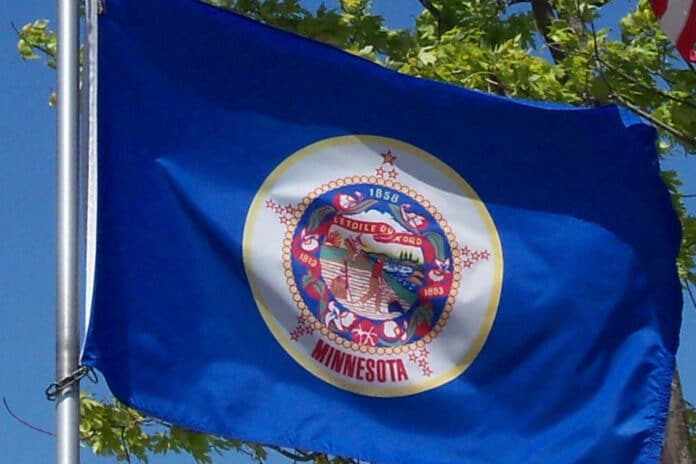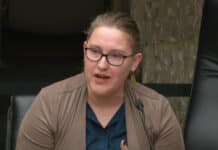A newly-created group charged with redesigning Minnesota’s state flag will hold its first meeting this week.
The 16-member State Emblems Redesign Commission will meet Tuesday morning, Sept. 5, according to Allison Ortiz of the Minnesota Historical Society, which is helping provide administrative support for the new body. An agenda for the meeting was posted on Friday.
The commission was formed via legislative declaration this summer after the DFL-controlled House and Senate passed an omnibus state government bill along party lines that included a controversial provision that aims to ditch the state’s official flag and seal in favor of a new design. The new statute instructs the commission to create a design that “accurately and respectfully reflect Minnesota’s shared history, resources, and diverse cultural communities.” It has four months to create a new state seal and flag design and submit it to the legislature by Jan. 1, 2024.
While the legislature will review the final designs, the statute instructs that “the design of the state flag as certified in the report of the State Emblems Redesign Commission, as established by this act, is adopted as the official state flag” and will become official on May 11, 2024 — which happens to be the anniversary of Minnesota’s statehood. Republicans lobbied hard for the legislature to have the final say on the redesigned state seal and flag. But DFL legislators stuck with their original language in a final conference report on the bill.
Gov. Tim Walz signed the provision creating the commission into law on May 24. Since then, per the statute, the governor, DFL and Republican caucuses in the legislature and a handful of organizations connected to state government have appointed members to the body tasked with the redesign effort. They include the following voting members:
Shelley Buck, appointed by Gov. Walz
- Buck serves as vice president for the Prairie Island Tribal Council and was named by Walz as chair for the State Emblems Redesign Commission.
Anita Gaul, appointed by Gov. Walz
- Gaul is a former DFL state Senate candidate and community college history teacher from Worthington.
Michael Harralson, appointed by Gov. Walz
- Harralson is a tribal law attorney and judge, and a resident of Minneapolis.
Dr. Kate Beane, selected by the Capitol Area Architectural and Planning Board
- Beane, executive director for the Museum of Minnesota Art, was one of the founding organizers of a movement that began nearly a decade ago to rename Lake Calhoun in Minneapolis. Beane, who is American Indian, was born in Arizona and grew up in Nebraska and California, but attended college at the University of Minnesota, where she earned a PhD in American Studies and taught American Indian Studies. In 2019, the city of Minneapolis began recognizing Lake Calhoun as Bde Maka Ska, and by 2020, the state did as well.
Lauren Bennett McGinty, executive director for Explore Minnesota Tourism
- Bennett McGinty was appointed by Walz in 2021 to lead the state’s tourism bureau. She had previously served as executive director of the Minnesota Craft Brewers Guild.
Philip McKenzie, chair of the Minnesota State Arts Board
- McKenzie is an adjunct oboe instructor at the University of North Dakota and North Dakota State. He was elected to serve as director of the Minnesota State Arts Board in 2021, and will serve as the organization’s representative on the commission.
Steve Simon, Minnesota Secretary of State
Kent Whitworth, CEO/director for Minnesota Historical Society
Luis Fitch, selected by the Council on Latino Affairs
- Artist and designer
Kim Jackson, selected by the Council on Asian Pacific Minnesotans
- Photographer
Denise Mazone, selected by the Council on Minnesotans of African Heritage
- Mazone is a realtor and in 2022 was named the first black president for the Minneapolis Area Association of Realtors in its 135-year history. The organization last year publicly apologized for the “industry’s role in the racial gap in Twin Cities homeownership,” according to a Star Tribune story.
Aaron Wittnebel, selected by the Minnesota Indian Affairs Council – Ojibwe Community
- Wittnebel is the former mayor of Lake Park, a city of about 700 people in west central Minnesota. About nine years ago he served a short sentence in jail related to charges that he stole more than $5,000 from his sister, while she was a patient at an assisted-living facility, according to a 2014 story published in the Pine Lakes Echo Journal.
A seat to be selected by the Minnesota Indian Affairs Council – Dakota Community has not yet been filled.
The commission also includes four legislators chosen by leaders in their respective caucus. These are non-voting members, but will be able to contribute to discussions surrounding the redesign effort:
Sen. Steve Drazkowski, R-Mazeppa
- Drazkowski floated an idea in a February state Senate hearing on the state emblems redesign bill suggesting the legislature adopt the logo of the former Minnesota North Stars NHL hockey team as the new state flag. Drazkowski offered an amendment to replace the proposed commission with a statute making the North Stars logo the new state flag. He received support from all the Republicans on the committee, but DFL senators voted down the proposal 7-6.
Rep. Mike Freiberg, DFL-Golden Valley
- Freiberg sponsored the emblems redesign legislation in the House; he spoke numerous times about the need to “retire” the current state flag, saying it represents the racially prejudiced views of its creator toward American Indians and its design is boring.
Sen. Mary Kunesh, DFL-New Brighton
- Kunesh sponsored the legislation in the Senate; she has said numerous times that the current Minnesota flag and seal represent a historical context that is hurtful to the American Indian community in Minnesota.
Rep. Bjorn Olson, R-Fairmont
Hank Long
Hank Long is a journalism and communications professional whose writing career includes coverage of the Minnesota legislature, city and county governments and the commercial real estate industry. Hank received his undergraduate degree at the University of Minnesota, where he studied journalism, and his law degree at the University of St. Thomas. The Minnesota native lives in the Twin Cities with his wife and four children. His dream is to be around when the Vikings win the Super Bowl.















